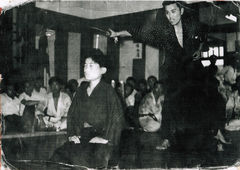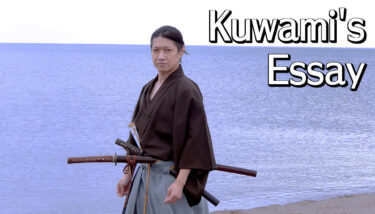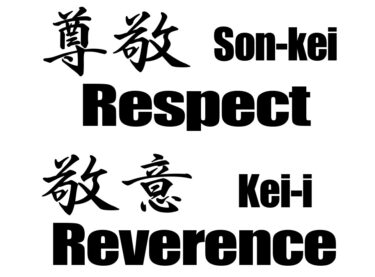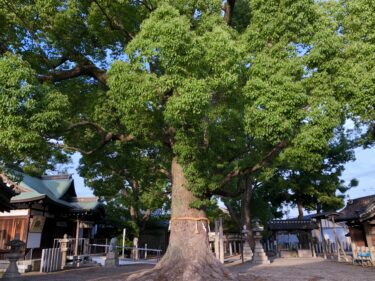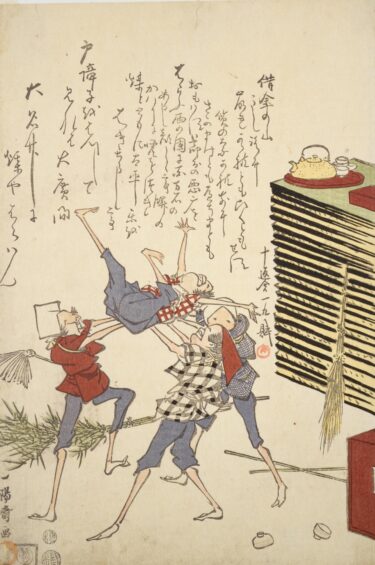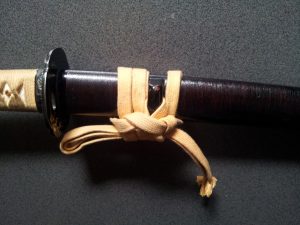Today, Tenshin-ryu has achieved a certain level of recognition, but 17 years ago—in 2008, when I (the author) first joined—it was still an entirely unknown and obscure style.
Within some circles of traditional martial arts, Tenshin-ryu was already infamous, due to Tenshin Sensei’s many years of uninhibited behavior and outspoken comments.
Tenshin Sensei is a staunch Tenshin-ryu supremacist. Both in his over half-century of martial arts demonstrations and daily life, he would consistently and directly criticize other styles. More than that, he was simply rude.
As a result, both he and Tenshin-ryu became somewhat notorious—negatively so—within the small community of traditional martial arts. However, this was only within that niche world.
(Incidentally, whenever I meet someone involved in traditional martial arts for the first time, I always ask whether they have ever met Tenshin Sensei. This is because anyone who has met him has inevitably been subjected to something rude or offensive, and I feel it is my duty to apologize on his behalf.)
Back then, the internet was far from what it is now—there wasn’t even a website—so it’s only natural that Tenshin-ryu was largely unknown.
About three years before I joined, I was introduced to Tenshin-ryu through Ide Sensei, who would later become my senior. At the time, he was still a university student. Even when I heard it was a branch of Shinkage-ryu, it was a name I had never encountered.
Several years after I joined, I realized that even the “Illustrated Encyclopedia of Japanese Martial Arts,” which I owned at the time, did in fact contain a brief mention of Tenshin-ryu, citing Gekken Sodan.
After joining, I spent a full year persuading Tenshin Sensei to let me build a website. I modified a template and launched it myself, created an official Twitter (now X) account, started uploading videos to YouTube, and later expanded to Instagram, Facebook, and more recently, TikTok. I’ve poured immense effort into promoting the style across various social media platforms.
Because “If it isn’t known, it’s the same as not existing.”
While I’ve enjoyed both the training and the promotional work, in truth, it’s been an ongoing struggle. But those years of hardship have paid off, and now our total following exceeds 1.5 million.
However, with that recognition has come resentment—there has also been significant damage caused by attacks from jealous critics.
A particularly curious phenomenon in recent years is that some of these critics are using the very knowledge spread through Tenshin-ryu’s outreach to attack it.
For example, from the beginning of our public outreach, we’ve taught about proper ways to place the sword. Now, we’re seeing people—both in Japan and overseas—misusing secondhand or hearsay knowledge to make incorrect criticisms.
In one case, someone lectured Maako Sensei (who is male) saying, “Your grip on the sword is all wrong.” When Maako Sensei replied, “Then please show me the correct grip,” the critic responded by sending an instructional photo of a sword grip—from Tenshin-ryu. It became a bit of a joke.
Back in 2015, our name recognition still wasn’t particularly high, but within traditional martial arts circles, we had gained some visibility as an up-and-coming school.
Around that time, through a student’s acquaintance, we received a warning: “Someone unrelated will almost certainly try to file a trademark application in the future.” In response, we submitted our own trademark application, which was approved on October 30, 2015.
(We still don’t have much money, and we had even less back then—so the cost was covered by donations from dedicated students.)
Of course, having a trademark doesn’t mean we can profit from it. But if someone were to make a bad-faith filing (known as “bogus trademarking”), it could seriously obstruct our work, and the process of overturning it would take a tremendous amount of time.
Some critics have even accused us of “falsely claiming to be the famous Tenshin-ryu!”—a completely baseless and irrational attack.
But as many of you already know, before our promotional efforts, no one in Japan (outside a very small martial arts niche) had ever heard of Tenshin-ryu.
In other words, we made it known. We established its public image. And now that very visibility is being used to attack us—an absurd situation.
These slanderous comments stem from ignorance, but since we can never know what kind of harassment or sabotage might arise, I’m very glad we took early action.
It’s worth noting that the name “Tenshin-ryu” is used by various other styles and in other fields. While these other Tenshin-ryu styles are unrelated, one of them had already registered the simpler trademark “Tenshin-ryu,” so we couldn’t register either “Tenshin-ryu” or “Tenshin-ryu Hyoho” as-is.
That’s why we trademarked the name “Edo Yagyu Tenshin-ryu Hyoho,” clearly reflecting our lineage and style.
What’s important is that the Kansai branch of the tradition has already died out. Only the Kanto-based Ishii family transmission remains. In this situation, there is a real risk of impersonators falsely claiming to be part of the style. (Of course, if an entirely separate legitimate lineage still exists, that would be a wonderful thing.)
This kind of piggybacking always happens once an old tradition becomes widely recognized, so taking legal steps like trademarks is one way to prevent such false claims. That, in itself, can be considered a form of hyoho—strategy.
Trademark issues can run surprisingly deep. There was once a major controversy when Louis Vuitton issued a warning to a Japanese Buddhist goods store, claiming their traditional beaded pouches with a checkered pattern infringed on their trademark.
But since that checkered pattern is a traditional motif used not just in Japan but around the world, the Japanese Patent Office ultimately invalidated the claim. (The same pattern is also famously featured in Demon Slayer.)
Even in the martial arts world, trademark issues come up regularly and sometimes lead to lawsuits.
In cases like ours—where other lineages have died out and there’s been a sudden rise in recognition—the risk of a bad-faith filing makes trademark protection worth considering. Otherwise, for most traditional martial arts, trademarks are not inherently necessary.
There’s no money to be made from trademarks in the first place.
Still, anti-Tenshin-ryu individuals continue to obsessively dedicate their valuable life time to obstructing us. We never know when someone might irrationally spend their own money just to sabotage us.
So as long as trademark law exists, more and more traditional martial arts styles may find themselves unable to avoid this path.
As I wrote in a previous blog post, I had hoped that our many years of documented activities would be considered “vested rights” (existing rights), but I’ve since learned that for such rights to be recognized in Japan, the style must be known by virtually the entire population. Even today, we are nowhere near that level.
In that sense, I suspect there are no koryu (classical martial arts) styles that meet that standard for vested rights.
Both Tenshin-ryu and traditional martial arts as a whole must continue striving to be correctly recognized—not just in Japan, but around the world.
Unfortunately, the martial arts world is rife with immature internet debates: Who’s stronger, what’s fake, and so on. These discussions are not only unproductive—they actively drive people away from this field.
I’ll cover this in detail in another post, but through seminars and demonstrations overseas, and through the many wonderful international students who have joined us, I’ve come to feel strongly about the importance of exporting morality.
Of course, each country has its own culture. Still, I believe that the true foundation of what makes Japan “Japan” lies in its moral education.
People from every nation are wonderful in their own way.
However, Japan’s unique culture of attentiveness and consideration, its actions rooted in empathy, and its aesthetic of seeing society and the environment as part of oneself—these values uphold Japanese society and have helped make this country such a pleasant place to live.
Hyper-individualism has also become a problem in Japan. Even in Tenshin-ryu, which emphasizes individualism, I feel the time has come to re-examine our approach.
Before we even think about exporting or teaching others, we must first look to our own foundation—Japan. If the traditional martial arts community here continues to belittle, disparage, and fight amongst itself, it will only grow more and more niche.
—
Kuwami Masakumo Isshin 鍬海 政雲 一心
